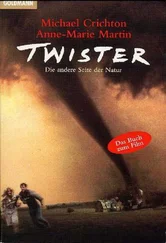Michael Crichton - State Of Fear
Здесь есть возможность читать онлайн «Michael Crichton - State Of Fear» весь текст электронной книги совершенно бесплатно (целиком полную версию без сокращений). В некоторых случаях можно слушать аудио, скачать через торрент в формате fb2 и присутствует краткое содержание. Жанр: Детская проза, на английском языке. Описание произведения, (предисловие) а так же отзывы посетителей доступны на портале библиотеки ЛибКат.
- Название:State Of Fear
- Автор:
- Жанр:
- Год:неизвестен
- ISBN:нет данных
- Рейтинг книги:4 / 5. Голосов: 1
-
Избранное:Добавить в избранное
- Отзывы:
-
Ваша оценка:
- 80
- 1
- 2
- 3
- 4
- 5
State Of Fear: краткое содержание, описание и аннотация
Предлагаем к чтению аннотацию, описание, краткое содержание или предисловие (зависит от того, что написал сам автор книги «State Of Fear»). Если вы не нашли необходимую информацию о книге — напишите в комментариях, мы постараемся отыскать её.
State Of Fear — читать онлайн бесплатно полную книгу (весь текст) целиком
Ниже представлен текст книги, разбитый по страницам. Система сохранения места последней прочитанной страницы, позволяет с удобством читать онлайн бесплатно книгу «State Of Fear», без необходимости каждый раз заново искать на чём Вы остановились. Поставьте закладку, и сможете в любой момент перейти на страницу, на которой закончили чтение.
Интервал:
Закладка:
APPENDIX I
Why Politicized Science Is Dangerous Imagine that there is a new scientific theory that warns of an impending crisis, and points to a way out.
This theory quickly draws support from leading scientists, politicians, and celebrities around the world. Research is funded by distinguished philanthropies, and carried out at prestigious universities. The crisis is reported frequently in the media. The science is taught in college and high school classrooms.
I don't mean global warming. I'm talking about another theory, which rose to prominence a century ago.
Its supporters included Theodore Roosevelt, Woodrow Wilson, and Winston Churchill. It was approved by Supreme Court justices Oliver Wendell Holmes and Louis Brandeis, who ruled in its favor. The famous names who supported it included Alexander Graham Bell, inventor of the telephone; activist Margaret Sanger; botanist Luther Burbank; Leland Stanford, founder of Stanford University; the novelist H. G. Wells; the playwright George Bernard Shaw; and hundreds of others. Nobel Prize winners gave support. Research was backed by the Carnegie and Rockefeller Foundations. The Cold Springs Harbor Institute was built to carry out this research, but important work was also done at Harvard, Yale, Princeton, Stanford, and Johns Hopkins. Legislation to address the crisis was passed in states from New York to California.
These efforts had the support of the National Academy of Sciences, the American Medical Association, and the National Research Council. It was said that if Jesus were alive, he would have supported this effort.
All in all, the research, legislation, and molding of public opinion surrounding the theory went on for almost half a century. Those who opposed the theory were shouted down and called reactionary, blind to reality, or just plain ignorant. But in hindsight, what is surprising is that so few people objected.
Today, we know that this famous theory that gained so much support was actually pseudoscience. The crisis it claimed was nonexistent. And the actions taken in the name of this theory were morally and criminally wrong. Ultimately, they led to the deaths of millions of people.
The theory was eugenics, and its history is so dreadfuland, to those who were caught up in it, so embarrassingthat it is now rarely discussed. But it is a story that should be well known to every citizen, so that its horrors are not repeated.
The theory of eugenics postulated a crisis of the gene pool leading to the deterioration of the human race. The best human beings were not breeding as rapidly as the inferior onesthe foreigners, immigrants, Jews, degenerates, the unfit, and the "feeble minded." Francis Galton, a respected British scientist, first speculated about this area, but his ideas were taken far beyond anything he intended. They were adopted by science-minded Americans, as well as those who had no interest in science but who were worried about the immigration of inferior races early in the twentieth century"dangerous human pests" who represented "the rising tide of imbeciles" and who were polluting the best of the human race.
The eugenicists and the immigrationists joined forces to put a stop to this. The plan was to identify individuals who were feeble-mindedJews were agreed to be largely feeble-minded, but so were many foreigners, as well as blacksand stop them from breeding by isolation in institutions or by sterilization.
As Margaret Sanger said, "Fostering the good-for-nothing at the expense of the good is an extreme cruelty amp;there is no greater curse to posterity than that of bequeathing them an increasing population of imbeciles." She spoke of the burden of caring for "this dead weight of human waste."
Such views were widely shared. H. G. Wells spoke against "ill-trained swarms of inferior citizens." Theodore Roosevelt said that "Society has no business to permit degenerates to reproduce their kind." Luther Burbank: "Stop permitting criminals and weaklings to reproduce." George Bernard Shaw said that only eugenics could save mankind.
There was overt racism in this movement, exemplified by texts such as The Rising Tide of Color Against White World Supremacy, by American author Lothrop Stoddard. But, at the time, racism was considered an unremarkable aspect of the effort to attain a marvelous goalthe improvement of humankind in the future. It was this avant-garde notion that attracted the most liberal and progressive minds of a generation. California was one of twenty-nine American states to pass laws allowing sterilization, but it proved the most forward-looking and enthusiasticmore sterilizations were carried out in California than anywhere else in America.
Eugenics research was funded by the Carnegie Foundation, and later by the Rockefeller Foundation. The latter was so enthusiastic that even after the center of the eugenics effort moved to Germany, and involved the gassing of individuals from mental institutions, the Rockefeller Foundation continued to finance German researchers at a very high level. (The foundation was quiet about it, but they were still funding research in 1939, only months before the onset of World War II.) Since the 1920s, American eugenicists had been jealous because the Germans had taken leadership of the movement away from them. The Germans were admirably progressive. They set up ordinary-looking houses where "mental defectives" were brought and interviewed one at a time, before being led into a back room, which was, in fact, a gas chamber. There, they were gassed with carbon monoxide, and their bodies disposed of in a crematorium located on the property.
Eventually, this program was expanded into a vast network of concentration camps located near railroad lines, enabling the efficient transport and killing of ten million undesirables.
After World War II, nobody was a eugenicist, and nobody had ever been a eugenicist. Biographers of the celebrated and the powerful did not dwell on the attractions of this philosphy to their subjects, and sometimes did not mention it at all. Eugenics ceased to be a subject for college classrooms, although some argue that its ideas continue to have currency in disguised form.
But in retrospect, three points stand out. First, despite the construction of Cold Springs Harbor Laboratory, despite the efforts at universities and the pleadings of lawyers, there was no scientific basis for eugenics. In fact, nobody at that time knew what a gene really was. The movement was able to proceed because it employed vague terms never rigorously defined. "Feeble-mindedness" could mean anything from poverty and illiteracy to epilepsy. Similarly, there was no clear definition of "degenerate" or "unfit." Second, the eugenics movement was really a social program masquerading as a scientific one. What drove it was concern about immigration and racism and undesirable people moving into one's neighborhood or country. Once again, vague terminology helped conceal what was really going on.
Third, and most distressing, the scientific establishment in both the United States and Germany did not mount any sustained protest. Quite the contrary. In Germany scientists quickly fell into line with the program. Modern German researchers have gone back to review Nazi documents from the 1930s. They expected to find directives telling scientists what research should be done. But none were necessary. In the words of Ute Deichman, "Scientists, including those who were not members of the [Nazi] party, helped to get funding for their work through their modified behavior and direct cooperation with the state." Deichman speaks of the "active role of scientists themselves in regard to Nazi race policy amp;where [research] was aimed at confirming the racial doctrine amp;no external pressure can be documented." German scientists adjusted their research interests to the new policies. And those few who did not adjust disappeared.
Читать дальшеИнтервал:
Закладка:
Похожие книги на «State Of Fear»
Представляем Вашему вниманию похожие книги на «State Of Fear» списком для выбора. Мы отобрали схожую по названию и смыслу литературу в надежде предоставить читателям больше вариантов отыскать новые, интересные, ещё непрочитанные произведения.
Обсуждение, отзывы о книге «State Of Fear» и просто собственные мнения читателей. Оставьте ваши комментарии, напишите, что Вы думаете о произведении, его смысле или главных героях. Укажите что конкретно понравилось, а что нет, и почему Вы так считаете.








